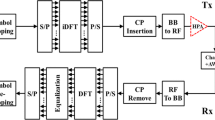Abstract
In this paper, we study the optimization of the guardbands between adjacent channels in OFDM-based cellular systems. It is well known that OFDM signals have strong sidelobes in spectrum, which lead to large necessary guardbands between adjacent channels to avoid severe adjacent channel interference. To reduce such guardbands and, thus, to increase the spectrum usage efficiency, we propose to apply raised cosine (RC) windowing of the time domain OFDM signals, which is a simple, efficient and effective method. In this context, an interesting tradeoff can be observed, i.e., a higher roll-off factor (ROF) of the RC-window is associated with higher signal overhead in time (in other words, longer OFDM symbol duration), but lower guardband overhead in frequency (due to better sidelobe suppression). We study this tradeoff and found out that the ROF and the guardband size can be jointly optimized, in the sense that the per-channel data rate can be maximized under adjacent channel interference constraints. Our mathematical analysis further shows that such joint optimization can be reduced to a single dimension optimization, i.e. the optimization of the ROF. Afterwards, this optimization procedure is illustrated and verified via numerical simulation, showing that large data rate increase can be achieved when using RC-windowing with an optimized ROF. Finally, practical analysis of the instantaneous per-OFDM symbol interference further verified the effectiveness of the proposed approach.










Similar content being viewed by others
Notes
Since the PL increases with the distance between Tx and Rx [12], such UTs receive relatively strong interference signal and relatively weak dedicated signal.
When the network parameters are known.
Recall that we consider the spectrum of a single OFDM symbol. In practice, \(P_\mathrm {S}\) is usually larger than \(\bar{P}_\fancyscript{Q}\) due to the spectral convolution in (4). Thus, using \(\bar{P}_\fancyscript{Q}\) to approximate \(P_\mathrm {S}\) leads to even stronger interference suppression.
Note that \(\rho _\mathrm {AC}^\mathrm {dB}\) is higher since the sidelobes shown in Fig. 7 will have additional attenuation of \(A_I^\mathrm {dB}\) dB before it interferes the adjacent channels.
In other words, if \(f_s=B\).
Further simulations show that reserving more guardband is much more effective than increasing \(r\).
References
Lawrey, E. P. (2001). Adaptive techniques for multiuser OFDM. Ph.D. dissertation, School of Engineering, James Cook University, Dec. 2001.
Brandes, S., Cosovic, I., & Schnell, M. (2006). Reduction of out-of-band radiation in OFDM systems by insertion of cancellation carriers. IEEE Communications Letters, 10(6), 420–422.
Cosovic, I., Brandes, S., & Schnell, M. (2006). Subcarrier weighting: A method for sidelobe suppression in OFDM systems. IEEE Communications Letters, 10(6), 444–446.
Cosovic, I., & Mazzoni, T. (2006). Suppression of sidelobes in OFDM systems by multiple-choice sequences. European Transactions on Telecommunications, 17, 623–630.
Mahmoud, H., & Arslan, H. (2008). Sidelobe suppression in OFDM-based spectrum sharing systems using adaptive symbol transition. IEEE Communications Letters, 12(2), 133–135.
Luo, J., Keusgen, W., Kortke, A. & Peter, M. (2008). A design concept for a 60 GHz wireless in-flight entertainment system. In IEEE 68th Vehicular Technology Conference (VTC’08-Fall), Calgary, Canada.
Ding, L., Zhou, G. T., Morgan, D. R., Ma, Z., Kenney, J. S., Kim, J., et al. (2004). A robust digital baseband predistorter constructed using memory polynomials. IEEE Transactions on Communications, 52(1), 159–165.
Peng, Z., Qin, Z., & Siliang, W. (2007). A novel adaptive digital predistortion for RF power amplifier linearization based on simplified volterra series. In Proceedings International Microwave Antenna, Propagation and EMC Technologies for Wireless Communications Symposium (pp. 327–331).
Liszewski, J., Schubert, B., Keusgen, W. & Kortke, A. (2011). Low-complexity FPGA implementation of volterra predistorters for power amplifiers. In Proceedings IEEE Topical Conference Power Amplifiers for Wireless and Radio Applications (PAWR) (pp. 41–44).
Luo, J., Liszewski, J., Schubert, B., Keusgen, W. & Kortke, A. (2012). Smart RF signal processing for advanced transmitters: From theory to practice. In International Symposium on Signals, Systems and Electronics (ISSSE), Potsdam, Germany (Sep. 2012, accepted).
Luo, J., Keusgen, W. & Kortke, A. (2008). Optimization of time domain windowing and guardband size for cellular OFDM systems. In IEEE 68th Vehicula Technology Conference (VTC’08-Fall), Calgary, Canada.
Feuerstein, M., Blackard, K., Rappaport, T., Seidel, S., & Xia, H. (Aug 1994). Path loss, delay spread, and outage models as functions of antenna height for microcellular system design. IEEE Transactions on Vehicular Technology, 43(3), 487–498.
Peter, M., Keusgen, W. & Kortke, A. (2007). Measurement and analysis of the 60 GHz in-vehicular broadband radio channel. In IEEE 66th Vehicular Technology Conference (VTC’07-Fall), Baltimore, USA.
Author information
Authors and Affiliations
Corresponding author
Additional information
The main contribution of Jian Luo was made when affiliated with Fraunhofer Heinrich Hertz Institute.
Appendix: Sidelobe Bound for an OFDM Signal with \(N_B\) OFDM Symbols
Appendix: Sidelobe Bound for an OFDM Signal with \(N_B\) OFDM Symbols
We extend Eq. (4) to describe an OFDM signal with \(N_B\) OFDM symbols as follows:
where \(b\) is the index of the OFDM symbol. The frequency response of this signal can be written as:
With \(\left| S_b[k]\right| \le \left| S_\mathrm {max}\right| \) and the triangle inequality, the following relations can be obtained:
which provide an upper-bound on the sidelobe level at the frequency \(f_\mathrm {\nu }\). Compared to (5), this upper-bound is just a scaled version with the factor \(N_B^2\). It can be easily shown that the average spectral power of the interference signal within its bandwidth also scales with \(N_B^2\). Therefore, the sidelobe reduction requirement remains the same as in (6). In other words, the analysis using a single OFDM symbol is equivalent to that using multiple OFDM symols.
Rights and permissions
About this article
Cite this article
Luo, J., Kortke, A. & Keusgen, W. Guardband Optimization for Cellular Systems Applying Raised Cosine Windowed OFDM. Wireless Pers Commun 78, 1375–1390 (2014). https://doi.org/10.1007/s11277-014-1822-z
Published:
Issue Date:
DOI: https://doi.org/10.1007/s11277-014-1822-z




